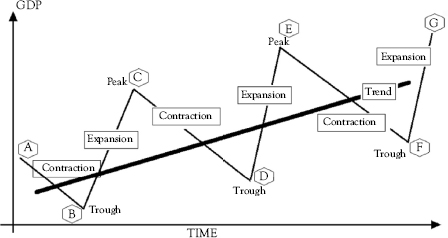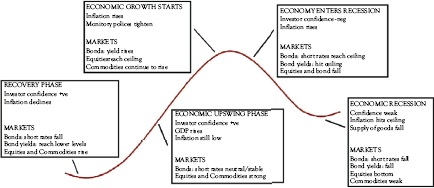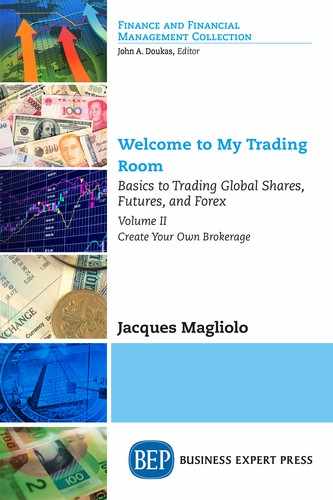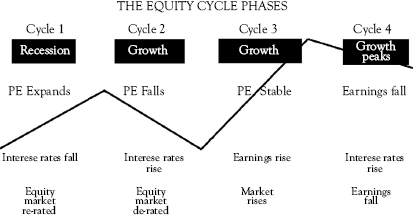Technical Indicator Wisdom 3
Long-term trends and daily charts enable you to determine the current trend and to follow it.
No market operates in a vacuum.
To render the investment horizon even more complex, globalization has spread sophisticated traders with even more sophisticated trading systems to far off shores, from China to Brazil. They have entered markets with speed and unpredictably, but even more important, with unbelievable buying power, finding undervalued stocks and closing gaps; buying without hesitation, but simply dumping them when there is a mere rumor of war or possible political interference with the economy.
Whichever way you see these changes in markets, prices can rise as quickly as they fall, confounding strategic plans of industry, while rescuing others from sheer and imminent bankruptcy.
These random forces strongly combine with economic laws of supply and demand and the cyclical nature of industry, to cause volatility, creating new peaks and troughs in shifting market that has become dynamic.
You may not be able to predict these forces, but by analyzing and understanding them, you can be better informed to make decisions about your portfolio.
A Basic Outline of the Investment Cycle
This section is a brief and basic outline of the investment cycle.
The following are influencing variables.
• Monetary conditions
• Earnings potential, forecasts, and results achieved
• Valuation methods
• Liquidity and tradability
• Uncertainty or risk profiles
Each of these variables can combine or singularly be effective on corporate profitability and therefore important to have a working knowledge of the investment cycle to enable you to make more informed decisions on timing your trades.
In fact, these variables should form part of your trading rules before you start trading. The ability to know when a specific market is strongest (most supported) or weakest (least supported) is a powerful trading tool.
The equity cycle can be split into four phases.
• An interest rate led market rally. This is the strongest stage of the equity cycle and is represented by Cycle 2 in the above diagram.
• Consolidation or correction. During this phase, inflationary expectations are reviewed in the market and the yield curve shifts upward.
• Stronger earnings. In Cycle 3 earnings expectations are revised upward.
• End of the bull run. In Cycle 4 investors begin to sell shares as earnings reach a peak. It is consistent with the start of the “cash phase” in the investment cycle.
The Business Cycle

It is an obvious statement to make that every business cycle is to some extent different, but there are usually some patterns that regularly repeat themselves. It is these that we are concerned with, in that fluctuations in this cycle essentially represent changes in economic growth, as represented by GDP. Even more important for traders is the rate of change in corporate profits, credit, employment rates, and inventory levels. These have over decades been reliable guides to understanding the different phases of an economic cycle and, consequently, the distinct phases of a typical business cycle.
• A business cycle is the period between consecutive cyclical peaks or troughs in business activity as measured by GDP; A-C, C-E, E-G, B-D, and D-F.
• A peak is defined as the last quarter of GDP growth above the cycle trend; A-C, C-E, and E-G.
• Correspondingly, a cyclical trough is the last quarter of growth below the trend line; B-D and D-F.
• The length of any economic cycle depends strictly on the country you are analyzing.
Independent stockbrokers need to understand cycle trends in first-world economies, as these directly affect emerging markets.
The following is an overview of such trends:
Summary of historic research:
• A turning point in GDP growth is usually reached first in the United States.
• The UK is traditionally not far behind and followed by France and Italy.
• The business cycle is, in turn, determined by the interest rate cycle.
• Rising interest rates in one period lead to growth in a future period.
• A slowdown in growth, in turn, leads to moderating inflation pressure and a fall in interest rates. It is the combination of these two variables that determine the investment cycle.
The Investment Cycle
A starting point is to determine the attraction of competing asset classes (equities, cash, and bond).
The cycle is based on the assumption that there is a time for each asset class to provide the trader with the greatest return possible. The extent of returns is dependent on the stage of key economic variables in a cycle.
Remember that an assessment is necessary to both competing assets and within each asset type. This means that if the cycle suggests “BUY Equities” then analysis is needed to identify which sectors and then which shares to buy, according to the rules you create.
An investment cycle exists because there is a direct link between interest rates and business cycles.
• A rise in interest rates tends to increase investors’ appetite for savings away from investment in the stock market.
• As inflation moderates interest rates will fall.
• Subsequently, lower interest rates will boost the economy.
• This will in turn lead to companies reaching capacity (production or service levels) constraints, i.e., there is a greater need for bank funds.
• The greater demand for goods over supply leads to higher interest rates.
The cycle that this creates has a different effect on market returns and, therefore, has key implications for asset allocation.
The following is a summary of the significant stages of an investment cycle.
The Equity Cycle
Brief overview:
• The cycle starts prior to the trough in economic activity as inflation improves.
• Ends within an average 9 months; before the peak in the economy.
• Associated with equity markets outperforming cash and bonds.
• Therefore, it is driven by economic and profits growth.
• This is the bull market for equities and the end of growth for bonds.
• It is also the end of economic recession.
The Cash Cycle
The equity market peaks before the economy and, during this period, interest rates continue to climb as demand over supply continues to grow and inflation consequently rises.
The economy starts to slowdown as higher interest rates dampen demand.
• As inflation slows, the bond market rises.
• When interest rates start to fall in conjunction to a slowing inflation rate, the equity phase starts the cycle once again.
It took me five years to write Jungle Tactics: Global Research, Investment & Portfolio Strategies (Heinemann, 2003) and much of that tine was taken up with assessing economic influences in the stock market. When reviewing the equity markets in detail through this economic cycle, the following conclusion was drawn, which could help you to complete your trading rules.
Notes:
• The strongest stock market returns are generated in the first phase of the economic cycle.
• It is theory that equities benefit from falling interest rates and forecasts of rising company profits. However, companies with high cash holdings will not benefit from a falling interest rate.
• The initial surge in equities is normally followed by a market consolidation.
• Markets then look for a recovery confirmation.
• Major variables driving bond prices are monetary conditions and the authorities’ response to economic developments.
The Equity Cycle
This cycle can be subdivided into three key influences, called stages in this book.
Stage 1: Interest Rate Driven
• As the economy remains weak or in recession, interest rates and bond yields fall together with the inflation rate.
• Lower interest rates raise forecasts of future growth in economic activity and profits.
• At this stage, the market starts to re-rate the equity market as PEs start to rise in the absence of earnings recovery.
Stage 2: Stock Correction
• As bond yields start to rise, equities start to consolidate or correct or derate.
• Another influence of a rise in bond yields, is a decline in PE ratios. This is the effect of a fall in share prices without a corresponding fall in EPS.
• This changes as earnings growth begins to come through in Cycle 3. Note that this is a consequence of improved investor sentiment and the expectation of higher profits.
Stage 3: Earnings Driven
• The equity bulls resume as company earnings rise.
• However, company share rise slower than when interest rates are falling.
The Cash Cycle
• This is a shorter stage than the equity or bond cycles.
• Therefore, this is the phase between equities and bonds.
• Consequently, the cash phase typically lasts from the peak in the equity cycle to the peak in bond yields.
The Bond Cycle
• There are two bull market phases for the bond cycle.
![]() The yield curve inverts as monetary policy tightens. This occurs as bond prices rise as investors perceive that inflation will fall. This is a leading indicator of a slowdown in GDP growth.
The yield curve inverts as monetary policy tightens. This occurs as bond prices rise as investors perceive that inflation will fall. This is a leading indicator of a slowdown in GDP growth.
![]() The curve shifts down as bonds continue to rise with an easing of monetary policy. This downward shift reflects lower inflationary expectations.
The curve shifts down as bonds continue to rise with an easing of monetary policy. This downward shift reflects lower inflationary expectations.
Cycles of Economy and Equities

From the above text, the following can be concluded:
• The investment cycle generates four key variables that drive equity performance, that form the basic structure of an investment process:
![]() Monetary conditions
Monetary conditions
![]() Earnings
Earnings
![]() Valuation
Valuation
![]() Liquidity
Liquidity
• Three distinct cycles occur as a consequence of the above variables, which results in the asset classes of equity, cash, and bonds outperform each other.
• The equity cycle split into three subsections that relate to:
![]() An interest rate driven phase
An interest rate driven phase
![]() A consolidation or correction phase
A consolidation or correction phase
![]() An earnings-driven phase
An earnings-driven phase
• The bond cycle has two bull market phases. The first reflects a change in the slope of the yield curve and the second phase is characterized by a shift downward in the curve as inflationary expectations are lowered.
Chapter 4 continues to set out essential analytical tools, explaining indices and economic statistics.

